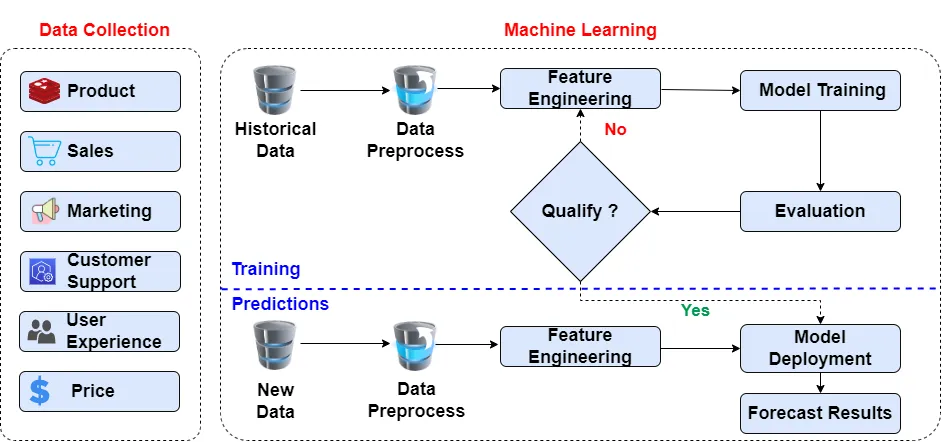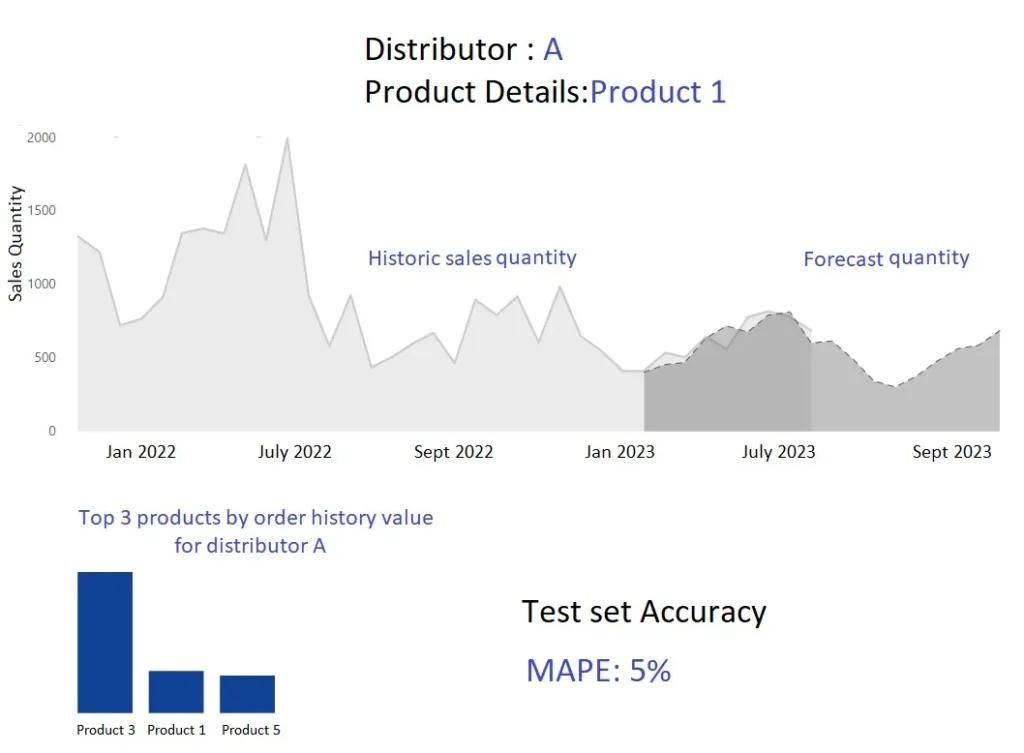Revolutionizing Supply Chain Demand Forecasting in Pharma and Healthcare with AI
Navigating Modern Challenges in Pharma Supply Chains
In today’s fast-paced, technology-driven environment, pharmaceutical and healthcare supply chains face unprecedented challenges. Supply chain disruptions, rapidly evolving customer needs, and economic uncertainties—exacerbated by the pandemic—highlight the urgent need for accurate, tech-enabled demand forecasting. Traditional methods, heavily reliant on historical data, struggle to account for real-time changes in market conditions. AI and ML technologies are stepping in to transform supply chain operations, ensuring precision, efficiency, and scalability.
Client Overview
We partnered with a leading global pharmaceutical company managing:
- 5000+ SKUs spanning prescription and non-prescription drugs, vaccines, and cosmetics.
- 1000+ stocking depots, 10+ manufacturing facilities, and 100,000+ sales outlets.
- Distribution networks covering offline retail, e-commerce, institutional buyers, and modern retail.
The client sought to address complexities in supply chain forecasting with cutting-edge AI solutions.
Challenges in Pharma and Healthcare Supply Chains
- Dynamic Demand Shifts: Unpredictable consumption patterns driven by pandemics and health crises.
- Data Silos: Fragmented data from prescriptions, institutional orders, distribution, and sales channels.
- Stock Management: Striking the balance between overstocking and stockouts, impacting costs and patient satisfaction.
- Regulatory Pressures: Adhering to strict compliance standards while ensuring smooth operations.
- Channel-Specific Variability: Tailoring forecasts for diverse distribution channels like e-commerce and institutional supply chains.
AI-Powered Solution Architecture for Demand Forecasting

The Image shows the main stages of the solution architecture, including:
1. Data Collection and Preparation:
- Consolidated data from ERP, CRM, and POS systems.
- Incorporated external variables such as public health alerts, prescription trends, and seasonal factors.
- Standardized and cleaned datasets to ensure reliability.
2. Feature Engineering:
Derived pharma-specific features, including:
-
- Lag indicators for restocking cycles.
-
- Regional healthcare trends to predict localized demand.
-
- Expiry forecasts to minimize product wastage.
3. Model Selection and Training:
- Applied state-of-the-art models like XGBoost and LSTM to handle intricate demand patterns.
- Trained models on historical sales, distribution timelines, and purchasing behaviors.
4. Model Evaluation:
- Evaluated model performance using Mean Absolute Percentage Error (MAPE).
- Fine-tuned models to adapt to erratic demand for critical drugs and vaccines.
5. Deployment and Real-Time Monitoring:
- Deployed AI models into a centralized platform offering real-time forecasts.
- Enabled stakeholders to:
- Adjust production schedules dynamically.
- Optimize inventory and reduce overstock risks.
6. Outcome Visualization:
- Delivered interactive dashboards for:
- Tracking product-level trends.
- Simulating various discount strategies.
- Assessing supply chain disruptions.
As an example, assume that one needs to forecast the sales quantity of Product 1 for the next three months, specifically for Distributor A. So, to make a forecast, the following historical input data is available spanning the past four years.

Upon completing the aforementioned steps outlined in the provided architecture, a set of methods have been tried to get the following results forecasted for Distributor A and Product 1

Transformative Impact of AI in Pharma Supply Chains
- Demand Sensing in Real Time: Monitors market trends and health crises to adjust forecasts.
- Automation: Reduces dependency on manual methods and eliminates biases.
- Enhanced Inventory Management: Cuts down on wastage and ensures availability.
- Scalability: Seamlessly handles global, multi-channel operations.
- Data-Driven Decisions: Empowers managers to respond proactively to challenges.
Measurable Benefits Delivered
- 98% Forecast Accuracy: Enhanced prediction for 5000+ SKUs.
- 30% Cost Reduction: Achieved through optimized inventory management.
- Rapid Adaptability: Faster response to market shifts during crises.
- Improved Patient Satisfaction: Ensured consistent availability of life-saving drugs.
Embracing AI for Pharma and Healthcare Supply Chains
AI-powered demand forecasting is no longer optional; it’s a necessity for organizations aiming to maintain a competitive edge. By leveraging advanced ML models and intelligent data platforms, pharmaceutical and healthcare businesses can:
- Respond swiftly to public health emergencies.
- Optimize production and reduce costs.
- Improve financial planning with accurate demand forecasts.
- Scale operations across complex, multi-regional supply chains.
Let’s Transform Together: Ready to explore how AI can optimize your supply chain operations? Connect with us to embark on this transformative journey.










https://t.me/rating_online/6
https://t.me/rating_online/3
https://t.me/s/rating_online/6
https://t.me/Online_1_xbet/3423
https://t.me/Online_1_xbet/2821
https://t.me/Online_1_xbet/2566
https://t.me/Online_1_xbet/2886
https://t.me/Official_1xbet_1xbet/s/208
https://t.me/Official_1xbet_1xbet/s/1328
https://t.me/Official_1xbet_1xbet/s/1345
https://t.me/Official_1xbet_1xbet/s/630
https://t.me/Official_1xbet_1xbet/s/451
https://t.me/Official_1xbet_1xbet/s/573
https://t.me/Official_1xbet_1xbet/s/252
https://t.me/Official_1xbet_1xbet/s/1408
https://t.me/Official_1xbet_1xbet/s/1262
https://t.me/Official_1xbet_1xbet/s/434
https://t.me/Official_1xbet_1xbet/s/786
https://t.me/Official_1xbet_1xbet/s/935
https://t.me/Official_1xbet_1xbet/s/677
https://t.me/Official_1xbet_1xbet/s/369
https://t.me/Official_1xbet_1xbet/s/1404
https://t.me/Official_1xbet_1xbet/s/1215
https://t.me/Official_1xbet_1xbet/s/946
https://t.me/Official_1xbet_1xbet/s/1373
https://t.me/Official_1xbet_1xbet/s/219
https://t.me/Official_1xbet_1xbet/s/565
https://t.me/s/Official_1xbet_1xbet/1823
https://t.me/s/Official_1xbet_1xbet/1792
https://t.me/Official_1xbet_1xbet/1718
https://t.me/s/Official_1xbet_1xbet/1822
https://t.me/s/Official_1xbet_1xbet/1835
https://t.me/Official_1xbet_1xbet/1748
https://t.me/s/Official_1xbet_1xbet/1684
https://t.me/Official_1xbet_1xbet/1707
https://t.me/s/Official_1xbet_1xbet/1759
https://t.me/Official_1xbet_1xbet/1599
https://t.me/s/Official_1xbet_1xbet/1632
https://t.me/Official_1xbet_1xbet/1733
https://t.me/s/Official_1xbet_1xbet/1601
https://t.me/Official_1xbet_1xbet/1778
https://t.me/s/Official_1xbet_1xbet/1657
https://t.me/Official_1xbet_1xbet/1841
https://t.me/Official_1xbet_1xbet/1664
https://t.me/s/Official_1xbet_1xbet/1612
https://t.me/s/Official_1xbet_1xbet/1697
https://t.me/Official_1xbet_1xbet/1598
https://t.me/s/Official_1xbet_1xbet/1661
https://t.me/Official_1xbet_1xbet/1679
https://t.me/Official_1xbet_1xbet/1680
https://t.me/s/topslotov
[https://t.me/s/official_1win_aviator](https://t.me/s/official_1win_aviator)
https://t.me/reiting_top10_casino/5
https://t.me/s/reiting_top10_casino/4
https://t.me/s/reiting_top10_casino/10
https://t.me/s/reiting_top10_casino/2
https://t.me/reiting_top10_casino/2
https://t.me/s/reiting_top10_casino/7
https://t.me/reiting_top10_casino
https://t.me/reiting_top10_casino/7
https://t.me/s/reiting_top10_casino/3
https://t.me/s/reiting_top10_casino/9
https://t.me/reiting_top10_casino/10
https://t.me/s/reiting_top10_casino/6
https://t.me/reiting_top10_casino/9
https://t.me/reiting_top10_casino/3
https://t.me/reiting_top10_casino/4
https://t.me/s/reiting_top10_casino/8
https://t.me/reiting_top10_casino/8
https://t.me/reiting_top10_casino/6
https://t.me/s/Gaming_1xbet
https://t.me/s/PlayCasino_1win
https://t.me/s/PlayCasino_1win
https://t.me/s/PlayCasino_1xbet
https://t.me/s/PlayCasino_1xbet
https://t.me/s/ofitsialniy_1win/33/kes
https://t.me/s/Official_beefcasino
https://t.me/s/iw_1xbet
https://t.me/s/ofitsialniy_1win
https://t.me/bs_1xbet/5
https://t.me/bs_1xbet/48
https://t.me/bs_1xbet/10
https://t.me/bs_1xbet/27
https://t.me/bs_1xbet/49
https://t.me/bs_1xbet/7
https://t.me/bs_1xbet/37
https://t.me/bs_1xbet/51
https://t.me/bs_1xbet/15
https://t.me/Beefcasino_rus/55
https://t.me/s/Best_promocode_rus/1219
https://t.me/s/Best_promocode_rus/2780
https://t.me/s/Beefcasino_rus/57
https://t.me/s/Beefcasino_rus/59
https://t.me/s/official_1win_aviator/38
https://t.me/s/Ud_KEnT
https://t.me/official_1win_aviator/61
https://t.me/s/UD_iRWIn
https://t.me/s/Ud_catcasINo
https://t.me/s/Official_mellstroy_casino
https://t.me/s/UD_PlAYfoRtuNA
https://t.me/s/UD_drIp
https://t.me/s/tf_1win
https://t.me/s/kfo_1win
https://t.me/official_1win_aviator/249
https://t.me/s/UD_VODKA
https://t.me/s/Ud_joYCASino
https://t.me/s/official_1win_aviator/284
https://t.me/s/ke_Legzo
https://t.me/s/kef_Lex
https://t.me/s/ke_kent
https://t.me/s/ke_Pin_Up
https://t.me/s/kef_Rox
https://t.me/s/ke_PlayFortuna
https://t.me/s/ke_Booi
https://t.me/s/ke_MostBet
https://t.me/s/ke_Gama
https://t.me/s/ke_Gizbo
https://t.me/s/ke_Monro
https://t.me/s/ke_1Win
https://t.me/s/ke_Volna
https://t.me/s/ke_CatCasino
https://t.me/s/ke_Irwin
https://t.me/s/official_1win_aviator/226
https://t.me/s/ke_Vulkan
https://t.me/s/ke_Jet
https://t.me/s/official_1win_aviator/262
https://t.me/s/ke_Stake
https://t.me/s/ke_Starda
https://t.me/s/ke_1xSlots
https://t.me/s/ke_MrBit
https://t.me/s/kef_R7
https://t.me/s/ke_Casino_X
https://t.me/s/ke_Pinco
https://t.me/s/ke_Pokerdom
https://t.me/s/ke_Leon
https://t.me/s/ke_mellstroy
https://t.me/s/top_kazino_z
https://t.me/s/topcasino_v_rossii
https://t.me/s/a_Top_onlinecasino/9
https://t.me/a_Top_onlinecasino/3
https://t.me/a_Top_onlinecasino/18
https://t.me/topcasino_rus/
https://t.me/s/official_Vulkan_ed
https://t.me/s/official_Kometa_es
https://t.me/s/official_Stake_es
https://t.me/s/official_Pinco_ed
https://t.me/s/official_Starda_es
https://t.me/s/official_Martin_ed
https://t.me/s/official_Booi_ed
https://t.me/iGaming_live/4577
https://t.me/s/official_Kent_es
https://t.me/PinUp_egs/12
https://t.me/s/Flagman_egs/18
https://t.me/s/Daddy_egs/6
https://t.me/iGaming_live/4831
https://t.me/s/va_1xbet/22
https://t.me/va_1xbet/16
https://t.me/s/va_1xbet/14
https://t.me/surgut_narashchivaniye_nogtey/17
https://t.me/ah_1xbet/12
https://t.me/ah_1xbet/22
https://t.me/s/Best_rating_casino
https://t.me/s/reyting_topcazino/12
https://t.me/topcasino_rus/
https://t.me/a_Topcasino/3
https://t.me/top_ratingcasino/4
https://t.me/a_Topcasino/2
https://telegra.ph/Top-kazino-11-14-2
https://t.me/kazino_bez_filtrov
https://t.me/s/kazino_bez_filtrov
https://t.me/da_1xbet/10
https://t.me/da_1xbet/11
https://t.me/da_1xbet/7
https://t.me/da_1xbet/9
https://t.me/da_1xbet/4
https://t.me/da_1xbet/15
https://t.me/da_1xbet/3
https://t.me/s/reyting_topcazino/24
https://t.me/s/top_online_kazino/6
https://t.me/s/top_online_kazino/5
http://m.jqkx.daumee.co.kr/member/login.html?noMemberOrder&returnurl=https://t.me/Official_1xbet_1xbet/1780
https://t.me/s/om_1xbet/9
https://t.me/of_1xbet/882
Вин номер калина 1 хэтчбек — выбирай 1win и получай мгновенные бонусы за депозит до 100% + фриспины для слотов. Легкая регистрация, минимальный депозит — всего 10 рублей, быстрый вывод выигрышей и высокие коэффициенты по ставкам на спорт, лайв-ставки, кэшбэк до 10%, круглосуточный доступ к реальному выигрышу и новейшим слотам прямо из личного кабинета.
Скачай игры 1win и начинай выигрывать сегодня — более 500 слотов, ставки на спорт с высокими коэффициентами и лайв-ставки круглосуточно. Получи бонус за депозит до 10 000 рублей, фриспины, кэшбэк до 20%, а благодаря быстрому выводу средств и личному кабинету ты сможешь выводить выигрыши всего за несколько минут. Играйте виртуально и реально выигрывайте с 1win!
1win зеркало рабочее на сегодня онлайн прямо сейчас — заходи и играй в онлайн-казино и ставки на спорт с минимальным депозитом от 300 руб., быстрым выводом выигрышей и бонусами за депозит до 100%. Оцени высокие коэффициенты, фриспины и кэшбэк за ставки, пользуйся промокодами, получай реальные выигрыши, круглосуточный доступ и лёгкую регистрацию через личный кабинет. Развлекайся и зарабатывай, ведь тут ждут быстрые выплаты и увлекательные лайв-ставки!
Ваучер 1вин сегодня — шанс увеличить свой депозит до 5000 рублей с бонусами за первый взнос и фриспинами в онлайн-казино! Делайте ставки на спорт и играйте в слоты с высокими коэффициентами, быстрым выводом и кэшбэком до 10%, пользуйтесь промокодами для дополнительных бонусов за депозит и получайте реальный выигрыш уже при минимальном входе. Войдите в личный кабинет и наслаждайтесь круглосуточным доступом к лучшим ставкам, лайв-ставкам и мгновенными выплатами!
https://t.me/s/ef_beef
https://t.me/s/Official_Ru_1WIN
https://telegra.ph/Beef-kazino-11-25
https://t.me/mcasino_martin/780
https://t.me/Martin_officials
https://t.me/s/Volna_officials
https://t.me/s/officials_1GO
https://t.me/s/Legzo_officials
https://t.me/s/Fresh_officials
https://t.me/s/lex_officials
https://t.me/s/Flagman_officials
https://t.me/s/Monro_officials
https://t.me/s/Jet_officials
https://t.me/s/RejtingTopKazino
https://t.me/s/Beefcasino_officials
https://t.me/s/Martin_casino_officials
https://t.me/s/iGaming_live/4871
Can you be more specific about the content of your article? After reading it, I still have some doubts. Hope you can help me. https://www.binance.com/hu/register?ref=IQY5TET4